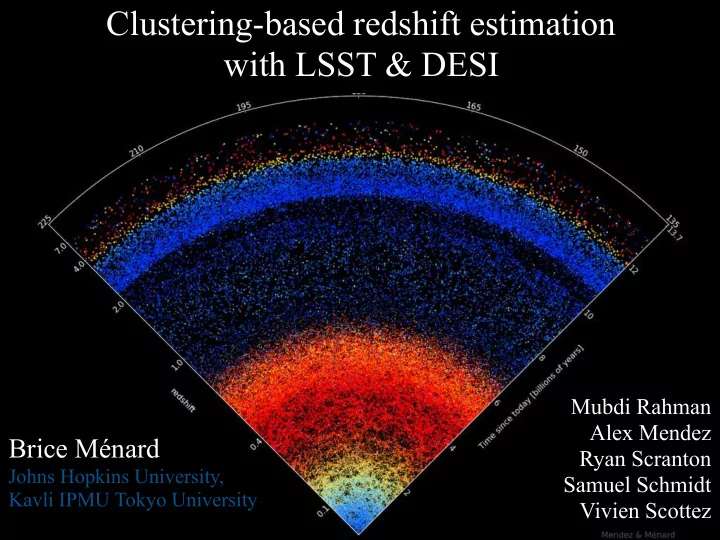

Clustering-based redshift estimation with LSST & DESI Mubdi Rahman Alex Mendez Brice Ménard Ryan Scranton Johns Hopkins University, Samuel Schmidt Kavli IPMU Tokyo University Vivien Scottez
What is a photometric redshift? Photometric redshift estimation is a mapping from the photometric space {F i } to redshift. Photometric space Dim ~ 10 brightness f ra,dec redshift space size Dim = 1 ellipticity … N~4 colors
What is a photometric redshift? Photometric redshift estimation is a mapping from the photometric space {F i } to redshift. Any measured property in {Fi} has an associated noise estimate. A photometric source is not just a point in {Fi} but a region defined by the noise level. p(z | {F i } ) does not apply to a given object but to a class of objects statistically indistinguishable. Color-based photometric redshifts are the same for all galaxies with similar colors (set by photometric errors).
What is a photometric redshift? Photometric space Dim ~ 10 brightness f ra,dec redshift space size Dim = 1 ellipticity … N~4 colors
Mapping the photometric space to redshift space Hildebrandt et al. Photometric space Dim ~ 10 brightness ra,dec redshift space size Dim = 1 ellipticity … N~4 colors ˆ f Photometric Redshifts SEDs or Training Sets
Mapping the photometric space to redshift space Photometric space Dim ~ 10 brightness ra,dec redshift space size Dim = 1 ellipticity … N~4 colors ˆ f Photometric Redshifts SEDs or Training Sets
Mapping the photometric space to redshift space ˆ f Schneider et al. (2006) Clustering Redshifts Ho et al. (2008) Spatial Correlation with Reference Set Newman (2008, 2010) Ménard et al. (2013) < ∂ . ∂ ref (ra,dec) > Schmidt et al. (2013) McQuinn & White (2013) Photometric space Dim ~ 10 brightness ra,dec redshift space size Dim = 1 ellipticity … N~4 colors ˆ f Photometric Redshifts SEDs or Training Sets < color . F ref ( λ ) >
? < ∂ i . ∂ unknown >
? < ∂ i . ∂ unknown >
Mapping the photometric space to redshift space ˆ f Clustering Redshifts Spatial Correlation with Reference Set < ∂ . ∂ ref (ra,dec) > ~ b(z) x dN/dz Photometric space Dim ~ 10 brightness ra,dec redshift space size Dim = 1 ellipticity … N~4 colors ˆ f Photometric Redshifts SEDs or Training Sets < color . F ref ( λ ) >
Applications of clustering redshifts SDSS optical CFHT-LS optical 2MASS near infrared WISE infrared
Applications of clustering redshifts ~100 million galaxies at SDSS optical x ∆ z CFHT-LS optical spectroscopic galaxy sample 2MASS near infrared r < 18 mag 1 million objects WISE infrared
Photometrically-selected galaxies = 1 sample 1: 0.5 < g-r < 0.6 ~ 6,300 galaxies sample 2: 1.3 < g-i < 1.4 ~ 10,000 galaxies sample 3: 1.2 < g-r < 1.3 ~ 2,500 galaxies Rahman et al. (2015)
Generalization to one million galaxies = 1 Rahman, BM et al. (2015)
Generalization to one million galaxies 15 Rahman, BM et al. (2015)
Comparison to photometric redshifts sample 2 sample 3 SDSS KD-tree photometric redshifts Rahman, BM et al. (2015)
Applications of clustering redshifts ~100 million galaxies at SDSS optical x ∆ z CFHT-LS optical Entire photometric sample 2MASS near infrared r < 22 mag 100 million objects WISE infrared
What can I do with 100 million photometric galaxies? information used: (u,g,r,i,z) + (ra,dec) u-g g-r r-i i-z color color color color color color color color
arXiv:1512.03057 Rahman, Mendez, BM et al. (2015)
arXiv:1512.03057 Rahman, Mendez, BM et al. (2015)
Comparison clustering-z vs photo-z Rahman et al. (2015)
Applications of clustering redshifts SDSS optical J H K CFHT-LS optical 1.0 1.5 2.0 2.5 λ [ µ m] 2MASS extended sources 2MASS near infrared K < 14 mag 1.5 million objects WISE infrared
Skrutskie et al. (2006) Observations: 1997-2001, J, H & K bands mean cluster-z Rahman et al. (2015)
Applications of clustering redshifts SDSS optical J H K CFHT-LS optical 1.0 1.5 2.0 2.5 λ [ µ m] 2MASS extended sources 2MASS extended sources 2MASS point sources near infrared K < 14 mag K < 14 mag 1.5 million objects 1.5 million objects WISE infrared
clustering redshifts for extended & point sources Rahman et al. (2015)
Difficult sources for photometric redshifts ~300,000 log N interlopers strongly lensed dust-reddened from ≠ z galaxies objects galaxy/AGN emission-line mergers driven sources
Clustering redshifts summary Cluster-z We have a new tool in hand to Photometric redshift space characterize the mapping between the photometric space and redshift Photo-z We can already deproject various cluster-z photometric datasets and obtain meaningful color-redshift tracks. color color color color
Recommend
More recommend